
To celebrate the 35th anniversary of The Legend of Zelda, we're running a series of features looking at a specific aspect — a theme, character, mechanic, location, memory or something else entirely — from each of the mainline Zelda games. Today, Kate marvels at the way A Link Between Worlds snuck in a bunch of big changes in disguise...
When I first played A Link Between Worlds, I, too, was a link between worlds. I'd played about one-sixth of A Link to the Past as a kid, unable to get past the first temple, but with about 20 hours plugged into the top-down world of Hyrule, I knew it like the back of my hand. My first few minutes in A Link Between Worlds pumped me full of nostalgia like a doughnut filled with memory jam, but it almost felt like unearned nostalgia for a game I was too crap to complete.
Luckily, A Link Between Worlds doesn't solely rely on your fond, fuzzy memories of its predecessor — it's fully its own thing. With the neat mechanic of "Link is a drawing now", a new world of possibilities opens up — largely to do with being two-dimensional, sure, but given that we currently have six mainline Paper Mario games, it's not like that's a limitation.

But this isn't a review. We already did one of those. You haven't come here to hear about the fact that A Link Between Worlds is good — it came out almost ten years ago, you already know that. You're here because we've been talking about the Zelda games in weird, interesting ways to celebrate the series' 35th anniversary. So, what does A Link Between Worlds bring to the table, other than the introduction of Ravio, the thinking man's Tingle?
The obvious answer is that, much like middle-aged millionaires, ALBW really loves the idea of renting. In real life, having to pay for the use of tools that used to be free might be grounds for a stern letter to your local council (or, at the very least, an angry tweet thread). In a Zelda game, it's a literal game-changer.
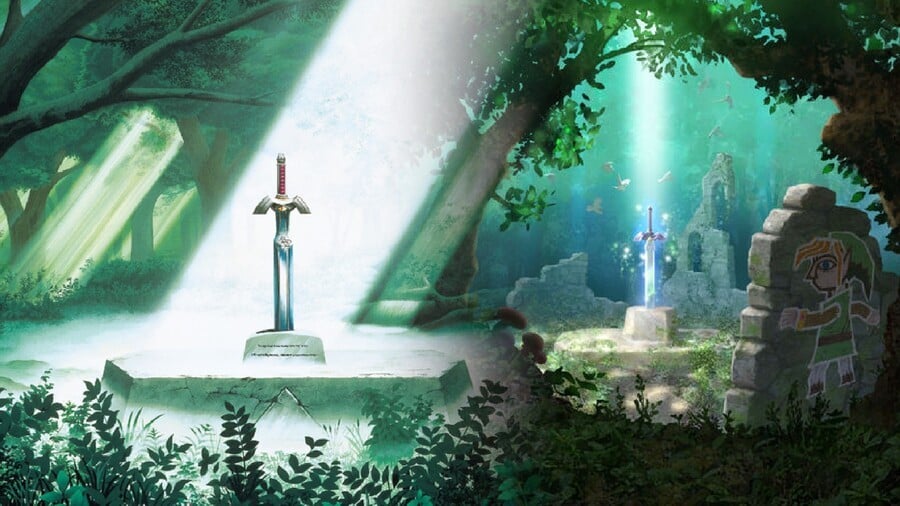
Suddenly, the world is your oyster, and you've just rented six different shucking devices. You don't have to do the Zelda sequence of going dungeon-by-dungeon, unlocking the hammer that lets you smash the boulder that gets you access to the dungeon with the magnifying glass that helps you see the tiny dungeon that has the Triforce in it, or whatever. Now you can go straight to whichever dungeon you want! You're not my dad, Ganon!
Now, I don't want to go all Tom Nook on you, but renting objects is an excellent incentive for Link's adventuring. Suddenly, rupees have meaning again, because they can be used to rent more items, and even buy them outright eventually. Sure, renting benefits the landlord itemlord far more than the renter, but isn't that just motivation to get richer so that you can become the itemlord? Hmmmmm. Between Animal Crossing and Zelda, I'm beginning to think that Nintendo games are just undercover landlord propaganda.
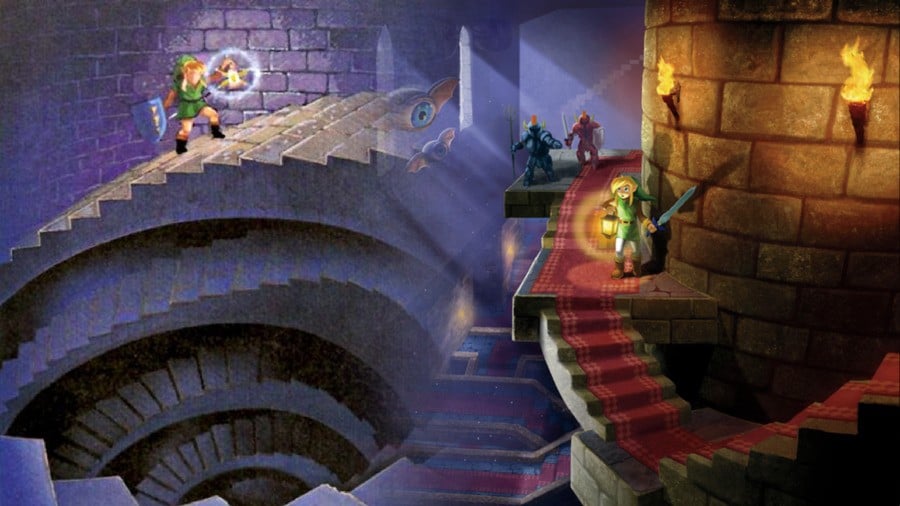
The best part about A Link Between Worlds (and, as I can often be heard yelling about after a few beers, every handheld Zelda) is that it's not afraid to toy with convention that its own designers invented. The general Zelda-loving public has all but canonised the Zelda oeuvre, to the point where we've now got a semi-established, sort-of-canon timeline that attempts to explain all the meaningless nonsense that went on in a lot of the early games.
Now, I do love a Zelda, but I'm not generally of the opinion that, for example, the team who made Majora's Mask did so with a decades-long legacy in mind. I think that a lot of Zelda games, especially the earlier ones that branch off in weird directions, were probably the result of the designers getting a bit bored with the established formula, and wanting to stretch their wings a little.
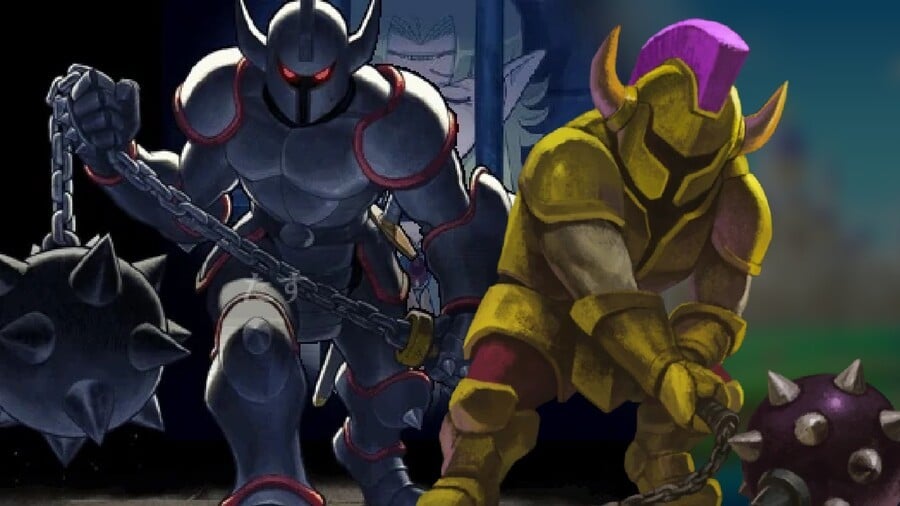
But, much like how everyone assumes that every tiny detail in Dark Souls is brimming with meaning, even if it's something like "this door doesn't open" or "I used debug codes to clip into this man's body and he has eyeballs inside his feet", people are very happy to ascribe various things in Zelda to the genius of its creators, rather than just being lucky accidents or beautiful mistakes. Don't get me wrong — there are a lot of extremely clever design decisions in Zelda games, and the designers at Nintendo are some of the best in the world — but that Hyrule Historia mega-timeline smacks of retconning to me.
But by the time A Link Between Worlds comes out, Zelda as a concept is a mint-in-box, never-opened, kept-in-a-glass-case series, as far as a lot of the fandom is concerned, and they don't tend to like it when things are different. Remember Wind Waker's reveal trailer? Or Skyward Sword's... everything?
It's wild to think about, because generally, the Zelda games that are most well-received after release are the ones that do things a bit differently, and yet, every time we get a trailer that makes it look like Link is wearing a slightly-different-colour-of-green tunic, we'll get all sorts of hand-wringing articles on game websites worrying that it's a misstep. And yes, I am almost definitely one of them. Listen, games journalists often have to spin 2000 words out of a single screenshot, we're just trying to have something interesting to say, ok?
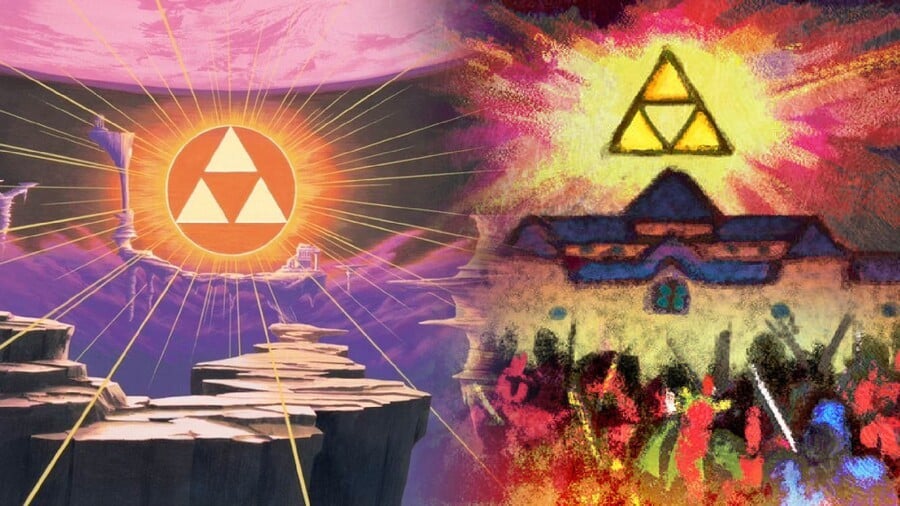
A Link Between Worlds not only plays with convention, it literally takes a sacred childhood memory — the world of A Link to the Past — and begins to shuffle it off the edge of a table like a cat with a glass of water. It paints over the top of a version of Hyrule we know and love, and shows us that, actually, change can not only be good, but it can be utterly transformative.
But A Link Between Worlds is also a sign of how tentative Nintendo could be in the pre-Switch era. For all the company's madcap experimentation, new ideas were often explored in the skins of old ones: Phantom Hourglass is set in the Wind Waker world; ALBW is set in exactly the same place as A Link to the Past; Skyward Sword is an attempt to patch up a hole in the timeline. Even in other Nintendo series released around the same time as ALBW, like Super Mario 3D World, the aesthetics are comfortingly similar. It's almost as though Nintendo's plan was to sneak in new things without totally spooking the fans, like hiding your dog's pills in a piece of steak.
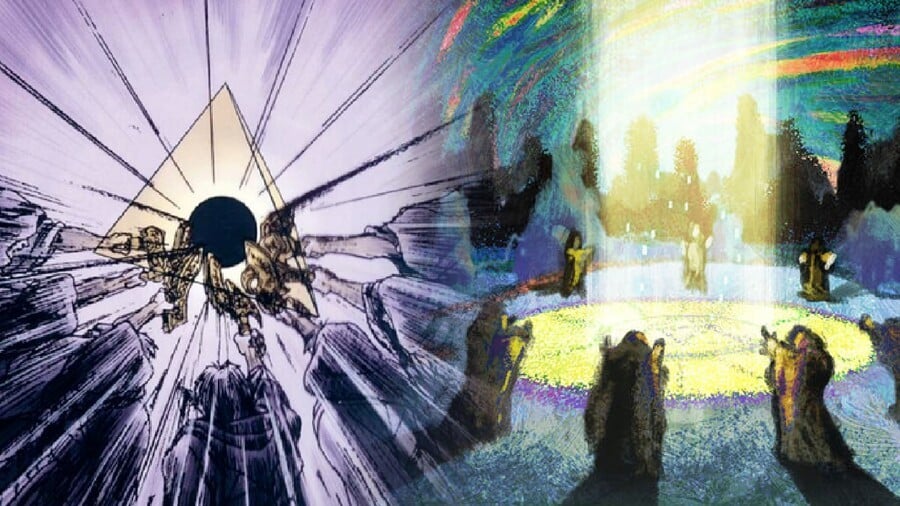
Of course, it worked. Breath of the Wild, the next game in the series (if you don't count Tri Force Heroes) was a breath of fresh air, set in a totally new world — I mean, yeah, it's Hyrule, but it's entirely open and you can do it in absolutely any order, which is 100% a part of A Link Between Worlds' DNA. Super Mario Odyssey changed stars into moons, and introduced a hat friend that literally turns Mario into different things. Change is scary, but Nintendo's gently experimental 3DS and Wii U games eased us into it.
So, A Link Between Worlds was part of Nintendo's plan to quietly, tenderly revitalise an old series. And who better to trust with your sacred nostalgia than the people who created it in the first place? Hopefully, with Breath of the Wild 2 coming soon (maybe), we can continue to see this pattern of change, new ideas, and zero fear in tearing up the paintings of the past and turning them into a brand-new collage.





Comments 60
Lmao I lost it at "I used debug codes to clip into this man's body and he has eyeballs inside his feet"
I was the same, I never really got that far in ALttP, and ALBW just seems so much better anyway. The ability to go to dungeons in (just about) any order and the wall merge mechanic just make it so much better and so much more creative. I love it when video games add mechanics like that that completely change the gameplay while still feeling true to the series' core concept, that is exactly how you keep a series feeling fresh and fun without causing too many complaints from fans about it feeling too different.
Ramblings of I don't know. Does anyone know what this article is about because I have read it twice and ...... meh
This was a welcome, unexpected game. I never thought we would see a 2d zelda again, let alone such an awesome one. This is a game I’d love to see on switch someday. My 3ds is a portable zelda machine, my switch needs to be too.
Having played every Zelda game (sans Four Swords) I can say that a Link Between Worlds is my favorite of the entire lot.
Breath of the Wild might be my favorite videogame, but not my favorite Zelda. It lacks all the charm and nostalgia of a typical Zelda game, which I felt aLBW captured perfectly.
I really hope ALBW finds its way to Switch in some form. Along with Skyward Sword, it's the only Zelda I've never played.
I don't like Breath of the Wild and I wish Nintendo was not making a 2nd one.
Great article. Now I want to go replay Link Between Worlds.
This was one of the Zelda games I chose to skip out on because I didn't play A Link to the Past. If I had the chance, I would play through it.
Unrelated to this article, the Age of Calamity bonus DLC was released today. Someone should write up a reminder.
@ModdedInkling You don’t need to play A Link To The Past to enjoy it. ALTTP is one of my least favourite Zeldas, but I loved this.
Love this game and, more than anything Zelda-related, I want a big, difficult (at least in some endgame?) 2d Zelda. Preferably looking more like this than LA.
Also, feel obliged to say, landlording is mostly a scummy, I would argue nigh-immoral, way of making a living. Know that’s beside the point, but you all brought it up.
Probably one of my most disappointing purchases of all time on release. I liked the idea of the game and was a big fan of the Zelda games I’d played beforehand (OoT, MM, TWW, TP and SS) but yeah, 2D Zelda eluded me for many years as I just found it massively boring. I did really enjoy the Link’s Awakening remake though. I sort of liked ALTTP when I finally completed it a couple of months ago too. So it makes me think that I should give this a second chance.
What was foreshadowed exactly? I got lost in the text.
ALBW was a big series highlight for me. Like Majora’s Mask and Skyward Sword changed things up after their predecessors, Breath of the Wild 2 is sure to do the same. I can’t wait to see to what extent this done. How much of a game changer it will be.
Wow... Outstanding Read. I really enjoyed that 💯
I'm sorry for rambling 😭 I just get excited and also easily distracted!!!
also I don't choose the titles, leave me alone
@GTHOLLAND
I have to agree with you here.
I genuinely think this game struck a better balance for Zelda than BotW, which is it's own fun but just doesn't feel like Zelda anymore
The funny thing is, ALBW is one of my absolute favourite Zelda games (along with ALttP and OoT) yet I didn’t get on with BotW at all. Aside from both being non-linear that’s where the similarities end for me.
The thing I like most about Zelda games is finding items to solve puzzles in dungeons and in the overworld, which ALBW had in spades. BotW didn’t really have any of that, it was just mashing random food together in the hopes it creates something that makes Link strong enough to not be one-shot killed by bosses. And even if you find a winning recipe rather than wasting your ingredients, you’ve still got to find them again to make it again and find somewhere to cook them. I just didn’t get BotW at all… 😢
ALBW had the greatest PACING of any game I have ever played. Each area explored pulled you to the next flawlessly. As it was an open-ish experience, it all felt organic. Each phase of progression EXCITED the player about the next phase of progression. And it all wrapped up in about 20 hours... just enough time for you to love every moment but brief enough that you wanted more.
The fact that the ending was so sweet and melancholy is something that I don't think any other Zelda has achieved narratively.
@GTHOLLAND I'm right there with you like WTH is this. I believe it is suppose to be about change and how Nintendo does small things in previous games that leads up to the big things. Thats the best I could interpret it.
Blows my mind that this game is almost a decade old already. What the heck is time, even?
Don't worry, the rambling was nice! It may not have been as fully thought out as some of your other features, but it was an entertaining read nonetheless!
My biggest disappointment in ALBW is that for some strange reason, it led to Triforce Heroes.
When the second Zelda game of a specific console comes out, it’s usually a much more streamlined affair for the developers to pump out because the engine is already there, waiting to be reutilized.
Majora’s Mask, Oracle of Seasons/Ages, Twilight Princess, and Spirit Tracks all reused assets from their predecessors to push out some incredibly fun and innovative titles (except for Spirit Tracks for me, but I’m very biased against the DS outings), and yet when the time came to finally get a wholly original Zelda game on the 3DS using ALBW’s engine, we got what was essentially the Federation Force of Zelda and I will forever feel disdain towards Nintendo for killing new 2D Zelda games with that half-hearted Four AdWords mockery.
“ So, what does A Link Between Worlds bring to the table, other than the introduction of Ravio, the thinking man's Tingle?”
Shameful. Ravio deserves better than that.
I literally didn't rent a single item in this game I bought all of them it bothered me there was a chance of dying and losing them and I made me anxious
@Euler True
@Muddy_4_Ever it was my first Zelda game and if I'd started with a different game I probably wouldn't have been close to as in love with it as now. This really is just a link to the past definitive edition but the changes are so weird and wacky like the painting thing and stuff man this is Nintendo at it's finest
This article is the equivalent of a 15 minutes youtube video with 10 minutes worth of introduction...
@Nameless_Shame What's weird is I adored spirit tracks I thought the puzzles were way more fun than in phantom hour glass and the story felt a little more lively to me as well but I guess that's an unpopular opinion for a reason lol
Right then, for balance from people who have issue with this piece I’d like to say that that I personally think this copy,and a lot of Kate’s articles, reads like a nice meandering conversation with a friend. The type of friend who would always get invited down the pub because they say the moat interesting things in the funnest way. I like a meander a lot more than I like a checklist, keep it up and don't go changing.
Never really played ALttP. Was a genesis kid. Didn’t make it far trying it out in later years. Did like ALBW tho
Another great article Kate. Link between worlds is the Zelda game that really started to bend the rules until BOTW snapped them in half
My only grief about albw is the incomplete world... lazy game design IMHO.
But I spends hours in the tavern to attend at the concert....
@GTHOLLAND You're not alone.....there's a lot of words that don't seem to actually say anything. I've read it a couple times and not sure what it's trying to say.
That aside, ALBW was a great game that I thoroughly enjoyed infinitely more than other experiments (like DS and Wii forced gimmick controls).
Honestly I preferred alttp to albw. I still enjoyed albw but it didn't really have that feel of progression and the difficulty curve was way off. Since the player could do most dungeons in any order Nintendo's solution was to give all the dungeons roughly the same difficulty. This lead to the game feeling a bit bland and easy. Botw suffered from the same problems. I hope Nintendo will be able to find a better balance between open-air and traditional zelda gameplay in the future.
Love ALBW, completed it numerous times and sm replaying it again currently.
LTTP was my 1st zelda and feels me with so much nostalgua and joy.
Absolutely love both of these
Love this game, and consider it one of the best, if not THE BEST, title to introduce kids to Zelda franchise.
You've got everything the series is known about: two "universes", puzzles, items, side-quests, exploration, very nice soundtrack, cool characters... Man I wish I had my 3DS here to play it again!
@Ghostchip I certainly didn’t hate the DS Zeldas, I just thought that the forced implementation of touch controls not only felt tacked on at the time, but made the games that much harder to go back and fully enjoy after the whole “touch generation” gimmick fell to the wayside, especially given that even the 3DS backed off a considerable amount with its first party efforts to force the stylus.
Which poses an even bigger threat for potential proper rereleases of these games in the future. Granted, the Wii U was an appropriate device to give them a second chance, but if anything, it just proved to me that the game shouldn’t have been locked to a touchscreen to begin with.
If there was ever a future remake of them, all the unique stylus control methods could be replaced with proper mapping of both analogue sticks. Skyward Sword HD is evidence enough that Nintendo is willing to recode its gimmicky games with traditional control schemes, but I feel that they would never bother to do so with any of the DS/3DS games...
@Nameless_Shame Meh Federation Force was alright.
I love A Link Between Worlds! It's my favorite 2D Zelda game, narrowly winning out over The Minish Cap and Link's Awakening in my book. I played ALttP not long before it for the first time via the GBA cartridge. While I agree that the 1991 original is an excellent Zelda game, ALBW took that source material, added more character development, its own interesting mechanics, more nonlinear dungeon progression, and a different way to use items via the rental system (even if I did buy them outright most of the time) to make a slightly better, more cohesive package. It also makes amazing use of the 3D effect and is one of my top recommended games for 3DS owners.
ALBW was a great game and I really enjoyed the renting system. I wouldn't mind if Breath of the Wild 2 had a similar structure. I didn't mind that Breath of the wild gave you all your tools for exploration pretty quick in the beginning but I also longed for the feeling of slowly gathering the tools you need to explore where you want.
I enjoyed this article as well but looking back when I read the title I expected that there was something in ALBW that foreshadowed the story in Breath of the Wild at first.
I enjoyed the game and appreciated it's break from conventions. But I'm not ready to call it better than or even equal to ALttP. At least in my book. Obviously, others feel differently.
I really think you should do these kind of articles in a video form, as they don’t really work in a written form most of the time and it seems plain unfocused at times, like an ADD fanboy/fangirl rambling
Otherwise, they are both great games and I wish someday I’ll get to play ALBW on Switch in remastered form, never had a 3DS
I grew up with Zelda, we were both young and new at the same time. Not once as a kid did I ever want or ask for a timeline. I realized early on that in every generation or so a hero, the princess, and an evil, would be born to duke it out. Might be 100 years in-between adventures, might be thousands. It's not a rough concept. So Nintendo concocted something we didn't want while refusing to give us something globally like Mother 3 that there's a legit and overwhelming demand for
@KateGray No worries Kate, that was a good article. I enjoyed it 🙂
I laughed at the landlord propaganda.
Also, why is there a man in dark souls with eyeballs in his feet?
@Munchlax
Ditto what Munchlax said.
Just recently purchased Soul Calibur 2 HD for the PS3. Great music and my favorite of the series. Although it didn’t have Link in the character selection, it was a great bonus on the GameCube version. Perhaps Nintendo and Namco can release the HD version of Soul Caliber 2 on the Switch someday. It was genius having Link in that game, and perhaps fitting and unique, especially for the Zelda anniversary - if they ever do it.
It was/is a great game. I can see where you are coming from. Good article, good read.
I think is easy to over think things. Nintendo makes games, games they hope will sell. So, do they keep to the Same game style, for example, Mario 64 or do they come up with something a bit different. They went for a bit different, Sunshine, But fans would have loved to see another couple of games like Marie 64, bigger castle paintings to jump through and more world's to explore.
New Lego games are released every year and they are all much the same. But for some reason Nintendo games like Zelda and Mario have to be different from the previous one. I don't think there is any great master plan that Nintendo are following for the direction of future Zelda games. And don't forget Nintendo were designing games for the Ds/3ds as well as their home console, so the game play and controls would be designed for the console in was intended for.
Nintendo consoles have never been that powerful and there games have been build with that in mind. BotW had to be compromised to run on the Switch. Imagine what it could have looked like.
You hear it here first:
BotW 2 will have an "Upside Down" world like A Link between Worlds. You have to constantly switch between these 2 worlds.
BotW 2 is like Majora's Mask, a darker sequel to Ocarina of Time.
Yeah, I agree with the Santa Claus theory of the Zelda timeline. That is to say that in Hyrule canon Zelda may be very loosely based on a real historical figure (like St. Nicholas), but it’s more of a legend that the hero will rise again during every period of national strife (just as Santa Claus will come to deliver gifts every Christmas) with the legend developing and getting more details over time through fables and carols.
A Link Between Worlds is not only an underrated game, it’s the best game in the Zelda franchise and also the 3DS’s best title. It did the impossible and topped it’s muse by becoming a more openworld experience, while still honouring and respecting the original source material. This NEEDS an enhanced Switch port!
So, again what was the point of this article?
@Nameless_Shame Yeah I agree I dislike the stylus moving scheme... I actually modded my ds to play without it lol
Edit: I was mostly saying in comparison to phantom hourglass tbh I really dislike phantom hourglass couldn't bring myself to even finish it
This is a beautiful concept and really did put a smile on my face. Thank you!
@EriXz for people like me to enjoy it, and you… to miss the point entirely 🤷♂️
@jt89p13 or maybe it does not make sense 🤷
@EriXz 🤷♂️ <3
Tap here to load 60 comments
Leave A Comment
Hold on there, you need to login to post a comment...